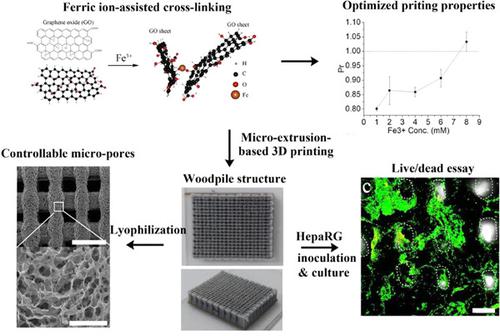当前位置:
X-MOL 学术
›
Biotechnol. Bioeng.
›
论文详情
Our official English website, www.x-mol.net, welcomes your
feedback! (Note: you will need to create a separate account there.)
Ferric ion crosslinking‐based 3D printing of a graphene oxide hydrogel and its evaluation as a bio‐scaffold in tissue engineering
Biotechnology and Bioengineering ( IF 3.5 ) Pub Date : 2020-10-06 , DOI: 10.1002/bit.27592 Renhao Lu 1, 2 , Wuhua Zhang 1 , Yuting He 3, 4 , Siyuan Zhang 1 , Qian Fu 3, 4 , Yuan Pang 1, 5 , Wei Sun 1, 5, 6
Biotechnology and Bioengineering ( IF 3.5 ) Pub Date : 2020-10-06 , DOI: 10.1002/bit.27592 Renhao Lu 1, 2 , Wuhua Zhang 1 , Yuting He 3, 4 , Siyuan Zhang 1 , Qian Fu 3, 4 , Yuan Pang 1, 5 , Wei Sun 1, 5, 6
Affiliation

|
As a precursor of graphene, graphene oxide (GO) exhibits excellent mechanical, thermal, and electrical properties, besides appreciable biocompatibility in tissue engineering applications. However, the current GO‐3D fabrication technology is still in need of optimization and simplification to ensure fine architecture and reasonable mechanical properties, which would further promote the performance of GO as bio‐scaffolds in cell or microorganism attachment and in material transformation. To address this issue, we proposed a GO ink, with appreciable rheological properties and excellent printing performance via high‐speed centrifugation and ferric ion‐assisted cross‐linking. A woodpile structure with controllable micro‐pores was produced by micro‐extrusion‐based 3D printing technology followed by an optimized freeze‐drying process. Cellular adhesion and viability were verified by inoculation and culture of HepaRG cells using the fabricated GO 3D structure, thus suggesting ferric ion‐assisted cross‐linking and controllable pore distribution for improving the performance of the GO construct as a bio‐scaffold for in vitro liver tissue models.
中文翻译:

基于铁离子交联的氧化石墨烯水凝胶的 3D 打印及其作为组织工程生物支架的评估
作为石墨烯的前体,氧化石墨烯 (GO) 除了在组织工程应用中具有可观的生物相容性外,还表现出优异的机械、热和电性能。然而,目前的 GO-3D 制造技术仍需要优化和简化,以确保精细的结构和合理的机械性能,这将进一步提升 GO 作为生物支架在细胞或微生物附着和材料转化方面的性能。为了解决这个问题,我们提出了一种通过高速离心和铁离子辅助交联具有显着流变特性和优异印刷性能的 GO 墨水。通过基于微挤压的 3D 打印技术和优化的冷冻干燥工艺生产出具有可控微孔的木桩结构。
更新日期:2020-10-06
中文翻译:

基于铁离子交联的氧化石墨烯水凝胶的 3D 打印及其作为组织工程生物支架的评估
作为石墨烯的前体,氧化石墨烯 (GO) 除了在组织工程应用中具有可观的生物相容性外,还表现出优异的机械、热和电性能。然而,目前的 GO-3D 制造技术仍需要优化和简化,以确保精细的结构和合理的机械性能,这将进一步提升 GO 作为生物支架在细胞或微生物附着和材料转化方面的性能。为了解决这个问题,我们提出了一种通过高速离心和铁离子辅助交联具有显着流变特性和优异印刷性能的 GO 墨水。通过基于微挤压的 3D 打印技术和优化的冷冻干燥工艺生产出具有可控微孔的木桩结构。










































 京公网安备 11010802027423号
京公网安备 11010802027423号